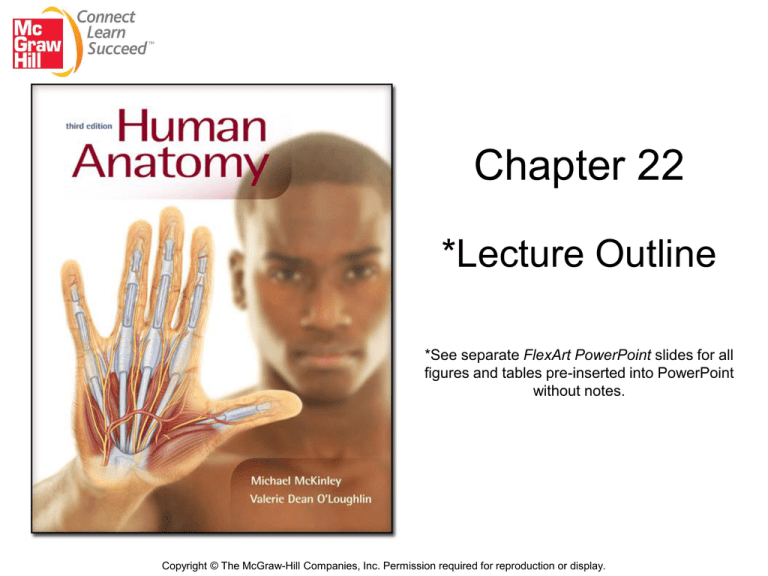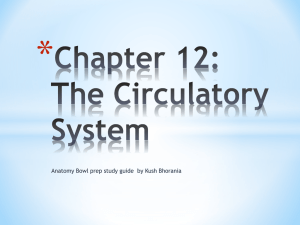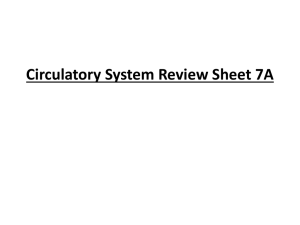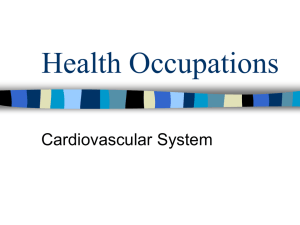Power Point CH 22
advertisement

Chapter 22 *Lecture Outline *See separate FlexArt PowerPoint slides for all figures and tables pre-inserted into PowerPoint without notes. Copyright © The McGraw-Hill Companies, Inc. Permission required for reproduction or display. Chapter 22 Outline • • • • • • • • Overview of the Cardiovascular System Anatomy of the Heart Coronary Circulation How the Heart Beats: Electrical Properties of Cardiac Tissue Innervation of the Heart Tying It All Together: The Cardiac Cycle Aging and the Heart Development of the Heart Overview of the Cardiovascular System • The heart propels blood to and from most body tissues via two basic types of blood vessels called arteries and veins. • Arteries are defined as blood vessels that carry blood away from the heart. • Veins are defined as blood vessels that carry blood back to the heart. • The arteries and veins entering and leaving the heart are called great vessels. General Characteristics and Functions of the Heart • Blood flow through the heart is unidirectional because of four valves within the heart. • The heart is functionally two side-by-side pumps that work at the same rate and pump the same volume of blood. – One pump directs blood to the lungs. – One pump directs blood to most body tissues. General Characteristics and Functions of the Heart • The heart generates blood pressure through alternate cycles of the heart wall’s contraction and relaxation. • Blood pressure is the force of the blood pushing against the inside walls of blood vessels. • A minimum blood pressure is essential to circulate blood throughout the body. Pulmonary and Systemic Circulations The cardiovascular system consists of two circulations: 1. Pulmonary—right side of the heart and the pulmonary arteries and veins; conveys blood to the lungs and back to the left side of the heart 2. Systemic—left side of the heart and arteries and veins; conveys blood to most body tissues and back to the right side of the heart Cardiovascular System Figure 22.1 Position of the Heart • Slightly left of midline deep to the sternum in a compartment of the thorax known as the mediastinum Figure 22.2 Position of the Heart • During development, the heart rotates such that the right side or right border (primarily formed by the right atrium and ventricle) is located more anteriorly. • The left side or left border (primarily formed by the left atrium and ventricle) is located more posteriorly. Position of the Heart • The posterosuperior surface of the heart is mainly the left atrium and is called the base of the heart. • The superior border is formed by the great arterial vessels and the superior vena cava. • The inferior conical end is called the apex. • The inferior border is formed by the right ventricle. Position of the Heart Figure 22.2 Pericardium • The heart is enclosed within a tough sac called the pericardium • Restricts heart movements so that it moves only slightly within the thorax Figure 22.2 Pericardium Composed of two parts: 1. Fibrous pericardium—outer covering of tough, dense connective tissue 2. Serous pericardium—composed of two layers: • • parietal layer—lines the inner surface of the fibrous pericardium visceral layer (epicardium)—covers the outer surface of the heart – the small space between the parietal and visceral layers is called the pericardial cavity Pericardium Figure 22.3 Anatomy of the Heart Wall The heart wall consists of three distinctive layers (from superficial to deep): 1. Epicardium—consists of the visceral layer of the serous pericardium and areolar connective tissue 2. Myocardium—cardiac muscle; thickest of the three layers 3. Endocardium—internal surface of the heart chambers and external surface of the heart valves Anatomy of the Heart Wall Figure 22.4 External Heart Anatomy • Composed of four hollow chambers: two smaller and superior atria (sing., atrium) and two larger inferior ventricles • The anteroinferior borders of the atria form a muscular extension called the auricle • The atria and ventricles are separated from each other by a relatively deep groove called the coronary sulcus • The anterior interventricular sulcus and posterior interventricular sulcus are located between the right and left ventricles and run from the coronary sulcus toward the apex of the heart External Heart Anatomy Figure 22.5 External Heart Anatomy Figure 22.5 Internal Heart Anatomy: Chambers and Valves The heart possesses four chambers: 1. Right atrium 2. Right ventricle 3. Left atrium 4. Left ventricle The heart also possesses four valves: 1. Right atrioventricular (tricuspid) 2. Pulmonary semilunar 3. Left atrioventricular (bicuspid or mitral) 4. Aortic semilunar Right Atrium Receives venous blood from heart, the muscles, and systemic circulation; three veins drain into the right atrium: 1. Superior vena cava 2. Inferior vena cava 3. Coronary sinus Separating the right atrium from the right ventricle is the right atrioventricular valve (tricuspid valve) Right Atrium Copyright © The McGraw-Hill Companies, Inc. Permission required for reproduction or display. Aortic arch Ligamentum arteriosum Ascending aorta Left pulmonary artery Superior vena cava Pulmonary trunk Right pulmonary artery Left pulmonary veins Right pulmonary veins Left atrium Right auricle Fossa ovalis Interatrial septum Opening for coronary sinus Right atrium Opening for inferior vena cava Right atrioventricular valve Aortic semilunar valve Left atrioventricular valve Pulmonary semilunar valve Trabeculae carneae Interventricular septum Chordae tendineae Left ventricle Papillary muscle Septomarginal trabecula Right ventricle Inferior vena cava Descending aorta Aortic arch Ligamentum arteriosum Ascending aorta Superior vena cava Pulmonary trunk Right auricle Right atrium Fossa ovalis Interatrial septum Pectinate muscle Opening for inferior vena cava Pulmonary semilunar valve Right coronary artery Interventricular septum Right atrioventricular valve Left ventricle Chordae tendineae Figure 22.6 Trabeculae carneae Papillary muscle Right ventricle Coronal section, anterior view © The McGraw- Hill Companies, Inc./Photo and Dissection by Christine Eckel Right Atrium • Deoxygenated venous blood flows from the right atrium to the right ventricle through the right atrioventricular valve. • The right atrioventricular valve is forced closed when the right ventricle begins to contract, preventing blood backflow into the right atrium. Right Ventricle • Receives deoxygenated venous blood from the right atrium • An interventricular septum forms a thick wall between the right and left ventricles • The inner wall of each ventricle displays large, irregular muscular ridges called trabeculae carneae Right Ventricle Copyright © The McGraw-Hill Companies, Inc. Permission required for reproduction or display. Aortic arch Ligamentum arteriosum Ascending aorta Left pulmonary artery Superior vena cava Pulmonary trunk Right pulmonary artery Left pulmonary veins Right pulmonary veins Left atrium Right auricle Fossa ovalis Aortic semilunar valve Interatrial septum Opening for coronary sinus Right atrium Opening for inferior vena cava Right atrioventricular valve Left atrioventricular valve Pulmonary semilunar valve Trabeculae carneae Interventricular septum Chordae tendineae Left ventricle Papillary muscle Septomarginal trabecula Right ventricle Inferior vena cava Descending aorta Aortic arch Ligamentum arteriosum Ascending aorta Superior vena cava Pulmonary trunk Right auricle Right atrium Fossa ovalis Interatrial septum Figure 22.6 Pectinate muscle Opening for inferior vena cava Pulmonary semilunar valve Right coronary artery Interventricular septum Right atrioventricular valve Left ventricle Chordae tendineae Trabeculae carneae Papillary muscle Right ventricle Coronal section, anterior view © The McGraw- Hill Companies, Inc./Photo and Dissection by Christine Eckel Right Ventricle • There are typically three cone-shaped muscle projections inside the right ventricle called papillary muscles. • The papillary muscles anchor thin strands of strong connective tissue made up of collagen fibers called chordae tendineae. • The chordae tendineae attach to three cusps of the (tricuspid) right atrioventricular valve. • Cusps are triangular flaps that hang down into the ventricle. • The chordae tendineae prevent the cusps from prolapsing into the right atrium when the right ventricle contracts. Right Ventricle Copyright © The McGraw-Hill Companies, Inc. Permission required for reproduction or display. Aortic arch Ligamentum arteriosum Ascending aorta Left pulmonary artery Superior vena cava Pulmonary trunk Right pulmonary artery Left pulmonary veins Right pulmonary veins Left atrium Right auricle Fossa ovalis Aortic semilunar valve Interatrial septum Opening for coronary sinus Right atrium Opening for inferior vena cava Right atrioventricular valve Left atrioventricular valve Pulmonary semilunar valve Trabeculae carneae Interventricular septum Chordae tendineae Left ventricle Papillary muscle Septomarginal trabecula Right ventricle Inferior vena cava Descending aorta Aortic arch Ligamentum arteriosum Ascending aorta Superior vena cava Pulmonary trunk Right auricle Right atrium Fossa ovalis Interatrial septum Figure 22.6 Pectinate muscle Opening for inferior vena cava Pulmonary semilunar valve Right coronary artery Interventricular septum Right atrioventricular valve Left ventricle Chordae tendineae Trabeculae carneae Papillary muscle Right ventricle Coronal section, anterior view © The McGraw- Hill Companies, Inc./Photo and Dissection by Christine Eckel Right Ventricle • At the superior end or roof of the ventricle is a smooth area called the conus arteriosus. • Beyond the conus arteriosus is the pulmonary semilunar valve, which marks the end of the ventricle and the beginning of the pulmonary trunk. Semilunar Valves • Two of them: pulmonary and aortic • Located in the roof of right and left ventricles, respectively • Each valve is composed of three thin, halfmoon-shaped, pocketlike semilunar cusps • When ventricles contract, blood pushes cusps against the arterial trunks • When ventricles relax, some blood flows back toward the ventricles, enters the pockets of the cusps and forces them toward midline, thus closing the valve Valves of the Heart Figure 22.7 Left Atrium • Oxygenated blood from the lungs travels through the pulmonary veins to the left atrium. • The left atrium is separated from the left ventricle by the left atrioventricular valve, which is also referred to as the bicuspid or mitral valve. • This valve only has two triangular cusps. • This valve is forced shut when the left ventricle contracts in a similar fashion to the closing of the right atrioventricular valve. Left Ventricle • The wall is typically three times thicker than the right ventricular wall. Figure 22.8 Left Ventricle • The left ventricle has to pump blood to the entire body, except for the lungs, and therefore has to generate a greater blood pressure. • At the superior end or roof of the left ventricle is the aortic semilunar valve, which marks the end of the left ventricle and the beginning of the aorta. Valves of the Heart Valves of the Heart Coronary Circulation • • The right and left coronary arteries travel within the coronary sulcus and supply the heart wall muscle with oxygen and nutrients. The coronary arteries are the only branches given off by the ascending aorta just superior to the aortic semilunar valve. Coronary Arteries Figure 22.9 Right Coronary Artery Branches into two arteries: 1. Marginal artery—supplies the right border of the heart 2. Posterior interventricular artery— supplies the posterior surface of the left and right ventricles Left Coronary Artery Branches into two arteries: 1. Anterior interventricular artery—also called the left anterior descending artery, supplies the anterior surface of both ventricles and most of the interventricular septum 2. Circumflex artery—supplies the left atrium and ventricle Coronary Veins Venous return of blood from the heart wall muscle occurs through three major veins: 1. Great cardiac vein—runs alongside the anterior interventricular artery 2. Middle cardiac vein—runs alongside the posterior interventricular artery 3. Small cardiac vein—travels close to the marginal artery All three of the above veins drain into a large vein called the coronary sinus that drains into the right atrium. Coronary Veins Figure 22.9 Conducting System of the Heart • The myocardium is composed of cardiac muscle fibers. • Cardiac muscle fibers contract as a single unit because they are all connected with low resistance cell-to-cell junctions called gap junctions. • Gap junctions comprise the intercalated discs shared by adjacent cardiac muscle fibers. • Therefore, an electrical impulse is distributed immediately and spontaneously throughout the myocardium. Comparison of Cardiac and Skeletal Muscle Structure of Cardiac Muscle Copyright © The McGraw-Hill Companies, Inc. Permission required for reproduction or display. Intercalated disc Openings of transverse tubules Intercalated disc Desmosome Gap junction Cardiac muscle cell Sarcolemma Nucleus Mitochondrion (a) Cross section of cardiac muscle cell Sarcomere Intercalated discs Striations Sarcolemma Transverse tubule Sarcoplasmic reticulum Nucleus Mitochondrion Myofibrils LM 1000x Z disc I band H zone M line Z disc (c) Longitudinal section of cardiac muscle I band A band (b) Cardiac muscle cell, longitudinal view Figure 22.10 c © Dennis Drenner/Visuals Unlimited Conducting System of the Heart • The heart exhibits autorhythmicity, which means it is capable of initiating its own heartbeat independent of external nerves. • The electrical impulse that initiates the heartbeat comes from specialized cardiac muscle cells called the sinoatrial (SA) node or the pacemaker. • The SA node is located on the posterior wall of the right atrium adjacent to the opening of the superior vena cava. • The SA node generates 70–80 impulses per minute under parasympathetic control. Conducting System of the Heart • Impulses from the SA node travel to the left atrium and the atrioventricular (AV) node located in the floor of the right atrium. • Electrical activity then leaves the AV node into the atrioventricular (AV) bundle (bundle of His), which extends into the interventricular septum. • Once within the septum, the AV bundle divides into left and right bundles. Conducting System of the Heart • These bundles pass the impulse to conduction cells called Purkinje fibers that begin at the apex of the heart. • The Purkinje fibers spread the impulse superiorly from the apex to all of the ventricular myocardium. Conducting System of the Heart Copyright © The McGraw-Hill Companies, Inc. Permission required for reproduction or display. Superior vena cava Right atrium Left atrium Sinoatrial node (pacemaker) Internodal pathway Atrioventricular node Atrioventricular bundle (bundle of His) Interventricular septum Right bundle Purkinje fibers Purkinje fibers Left bundles Internodal pathway Atrioventricular node Atrioventricular bundle 1 Muscle impulse is generated at the sinoatrial node. It spreads throughout the atria and to the atrioventricular node by the internodal pathway. 2 Atrioventricular node cells delay the muscle impulse as it passes to the atrioventricular bundle. Atrioventricular bundle Interventricular septum 3 The atrioventricular bundle (bundle of His) conducts the muscle impulse into the interventricular septum. Figure 22.11 Left and right bundle branches 4 Within the interventricular septum, the right and left bundles split from the atrioventricular bundle. Purkinje fibers 5 The muscle impulse is delivered to Purkinje fibers in each ventricle and distributed throughout the ventricular myocardium. Innervation of the Heart • The heart, like most other organs, is innervated by both the sympathetic and parasympathetic divisions of the autonomic nervous system. • The anatomical components of both divisions make up the coronary plexus. • Autonomic innervation does not initiate a heartbeat, but it can increase or decrease the rate of the heartbeat. Innervation of the Heart Figure 22.12 Sympathetic Innervation • Starts with neurons located in T1–T5 segments of the spinal cord • Preganglionic axons enter the sympathetic trunk and synapse on ganglionic neurons. • Postganglionic axons project from all three cervical ganglia and travel to the heart via cardiac nerves. • Sympathetic input to the heart increases the rate and force of heart contractions. Parasympathetic Innervation • Starts with neurons in the medulla oblongata via the left and right vagus nerves (CN X) • Decreases heart rate but generally has no effect on force of contraction Coordinated Sequence of Heart Chamber Contractions 1. SA node generates an impulse. 2. Both atria contract almost simultaneously (systole) while ventricles are relaxing (diastole). 3. Impulse goes to AV node and then to the ventricles. 4. Ventricles contract (systole) while atria relax (diastole). Ventricular Systole and Diastole Copyright © The McGraw-Hill Companies, Inc. Permission required for reproduction or display. (a) Ventricular Systole (Contraction) Aortic arch Blood flow into ascending aorta Ascending aorta Pulmonary trunk Blood flow into right atrium Blood flow into pulmonary trunk Right atrium Left atrium Ventricular contraction pushes blood against the open AV valves, causing them to close. Contracting papillary muscles and the chordae tendineae prevent valve flaps from everting into atria. Ventricles contract, forcing semilunar valves to open and blood to enter the pulmonary trunk and the ascending aorta. Atrioventricular valves closed Semilunar valves open Right ventricle Left ventricle Cusp of semilunar valve Cusp of atrioventricular valve Blood in ventricle Posterior Left AV valve (closed) Right AV valve (closed) Left ventricle Right ventricle Aortic semilunar valve (open) Pulmonary semilunar valve (open) Figure 22.13 Anterior Transverse section Ventricular Systole and Diastole Copyright © The McGraw-Hill Companies, Inc. Permission required for reproduction or display. (b) Ventricular Diastole (Relaxation) Aortic arch Blood flow into right atrium Blood flow into left ventricle Right atrium Left atrium During ventricular relaxation, some blood in the ascending aorta and pulmonary trunk flows back toward the ventricles, filling the semilunar valve cusps and forcing them to close. Blood flow into right ventricle Ventricles relax and fill with blood both passively and then by atrial contraction as AV valves remain open. Semilunar valves closed Atrioventricular valves open Atrium Right ventricle Cusp of atrioventricular valve Left ventricle Blood Cusps of semilunar valve Chordae tendineae Papillary muscle Posterior Left AV valve (open) Right AV valve (open) Left ventricle Right ventricle Aortic semilunar valve (closed) Pulmonary semilunar valve (closed) Figure 22.13 Anterior Transverse section Cardiac Cycle Copyright © The McGraw-Hill Companies, Inc. Permission required for reproduction or display. Atria contract Atria relax Atria relax Semilunar valves open AV valves open All valves closed Ventricles contract Ventricles relax 1 AV valves closed Atrial systole Atria contract; AV valves are open, semilunar valves are closed Phase Early ventricular systole Atrial systole Structure Atria Ventricles contract Early ventricular systole Atria relax; ventricles begin to contract; AV valves are forced closed (lubb sound); semilunar valves still closed 2 Late ventricular systole 3 Early ventricular diastole Late ventricular diastole Contract Relax Relax V entricles Relax Contract Relax A V valves Open Semilunar valves Time (seconds) Closed Closed 0.0 Open Open 0.1 0.2 Late ventricular systole Atria continue to relax; ventricles contract; AV valves remain closed; semilunar valves are forced open Closed 0.3 0.4 0.5 Atria relax 0.6 0.7 Atria relax Semilunar valves closed AV valves open All valves closed Ventricles relax 5 Figure 22.14 Late ventricular diastole Atria and ventricles relax; atria continue passively filling with blood; AV valves open and ventricles begin to passively fill; semilunar valves remain closed Ventricles relax 4 Early ventricular diastole Atria and ventricles relax; AV valves remain closed and semilunar valves close (dupp sound); atria continue passively filling with blood 0.8 Blood Flow Through the Heart Copyright © The McGraw-Hill Companies, Inc. Permission required for reproduction or display. Blood Flow Through the Heart Table 22.3 Systemic veins Superior and inferior venae cavae Right atrium Right atrioventricular valve Right ventricle Pulmonary semilunar valve Gas and nutrient exchange in peripheral tissues Systemic arteries Chamber of the Heart Pulmonary trunk and arteries Gas exchange in the lungs Aorta Aortic semilunar valve Receives Blood From Left ventricle Left atrioventricular valve Sends Blood To Left atrium Pulmonary veins Valves Through Which Blood Flows Right AV valve Right atrium Superior vena cava, inferior vena Right ventricle cava, coronary sinus Right ventricle Right atrium Pulmonary trunk (blood enters Pulmonary semilunar valve vessels of pulmonary circulation) Left atrium Pulmonary veins Left ventricle Left AV valve Left ventricle Left atrium Ascending aorta (blood enters vessels of systemic circulation) Aortic semilunar valve Development of the Heart Figure 22.15 Development of the Heart Figure 22.16 Development of the Heart









